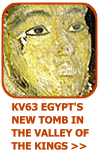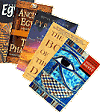|
|
||||||||||||
|
|
hieroglyphs - page1 | hieroglyphs - page 2
Making art out of writing The invention of script in the late fourth millennium BC marked a huge step in the cultural development of mankind. In ancient Egypt, the scribe was revered and honoured, and a seated scribe holding a papyrus roll was one of the most popular subjects in early ancient Egyptian art. Writing was considered to be the foundation for ordered life and government. Ideas, discoveries, wisdom and experience now need no longer die with the individual, but could be passed on to endless generations, indeed onto us, as we can read the literature, religious and scientific texts of these fascinating people. The 26 letter Roman alphabet is a distant but direct descendant of the complex ornate script of ancient Egypt. Scholars believe that this script inspired the development of the world's first alphabetic scripts, Phoenician and Aramaic, from which the Greek and Roman alphabets derive. Earlier still, it is thought that the idea of writing spread from Egypt to the Aegean, in particular influencing the mysterious and currently still undeciphered "Linear A" script of Minoan Crete, which has marked similarities to Egyptian hieroglyphs. The ancient Egyptian script, like other early scripts, was pictographic, where pictures were used to represent words like house, man, etc. Writing was associated with Thoth, the ibis headed god of learning and writing, and was referred to as "words of God". Later, the Greeks, retaining this original meaning, named the signs hieroglyphs, from the words "hieros" (meaning sacred) and "glyphen" (meaning to carve). Hieroglyphs make art out of writing and lend an extraordinary grace and beauty to inscribed text. Egyptian writing is a mixed script combining signs denoting ideas (ideograms) with phonetic signs. Hieroglyphic writing was in use from around 3200 BC until the late 4th century AD. It was used extensively with relatively little change in form for some 3,000 years, not only in Egypt but also throughout the Near Eastern territories under Egyptian influence or control. The script persisted well into the Christian era, with the last known datable hieroglyphic inscription carved on 24th August 394 AD on the gate of Hadrian at Philae. Hieroglyphs were usually written from left to right, but were also written from right to left, or in vertical columns. The direction of the human or animal forms indicate in which way the script should be read. Vowel sounds were consistently omitted, in very much the same way as Arabic or Hebrew.
The development of cursive scripts As time developed, so did the hieroglyphic script, from the formal classical style used on monuments, to a much simpler, cursive style. One style is known as "hieratic" (from the Greek hieratikos meaning "priestly") and the other is known as "demotic" (from the Greek demotikos meaning "popular"). The hieroglyphic system was used for funerary and religious texts, whilst the cursive Hieratic script was used primarily for administrative and literary texts. By the 26th Dynasty, the Demotic script had replaced Hieratic. These cursive scripts should not be confused with "cursive hieroglyphs", which were used for most of the Pharaonic period in religious writings, such as the "coffin texts" and the "Book of the Dead". The Egyptians used hieroglyphs for nearly 3,500 years, beginning in about 3300 BC until the end of the fourth century AD. Monumental use of hieroglyphs ceased after the closing of all non-Christian temples in AD 391 by the Roman Emperor Theodosius I and the last known inscription is from a temple far to the south not long after 391. At the beginning of the third century AD, the Egyptians began to write their languages in a script composed of the Greek alphabet, to which were added seven characters derived ultimately from hieroglyphs. In this form the language came to be known as Coptic, a corruption of the Greek word for Egypt, "Aiguptios". Knowledge of how to read and write the hieroglyphic script was probably lost soon after it had been superseded and no key to its meaning was found until the discovery of the Rosetta Stone.
Classical speculation Hieroglyphs fascinated many classical visitors to Egypt. The Greek historians, Herodotus (c.484-425 BC), and Diodorus, who lived at the time of Julius Caesar and travelled to Egypt between 60-57 BC, and the Roman historian Tacitus, (c.55-120 AD) were amongst those who mentioned these mysterious writings. Whilst these classical scholars rightly assumed that these hieroglyphs were concerned with historical events, it would be many more centuries before the secrets of the script would finally be revealed. The decipherment of hieroglyphs was the single greatest event in the development of Egyptology.
|
|||||||||||

|
||||||||||||
|
||||||||||||







